Related Research Articles

Carniola is a historical region that comprised parts of present-day Slovenia. Although as a whole it does not exist anymore, Slovenes living within the former borders of the region still tend to identify with its traditional parts Upper Carniola, Lower Carniola, and to a lesser degree with Inner Carniola. In 1991, 47% of the population of Slovenia lived within the borders of the former Duchy of Carniola.

Burgrave, also rendered as burggrave, was since the medieval period in Europe the official title for the ruler of a castle, especially a royal or episcopal castle, and its territory called a Burgraviate or Burgravate.

Count is a historical title of nobility in certain European countries, varying in relative status, generally of middling rank in the hierarchy of nobility. Especially in earlier medieval periods the term often implied not only a certain status, but also that the count had specific responsibilities or offices. The etymologically related English term "county" denoted the territories associated with some countships, but not all.

Spessart is a Mittelgebirge, a range of low wooded mountains, in the States of Bavaria and Hesse in Germany. It is bordered by the Vogelsberg, Rhön and Odenwald. The highest elevation is the Geiersberg at 586 metres above sea level.

In Japan, a district is composed of one or more rural municipalities within a prefecture. Districts have no governing function, and are only used for geographic or statistical purposes such as mailing addresses. Cities are not part of districts.

A bailiff is a manager, overseer or custodian – a legal officer to whom some degree of authority or jurisdiction is given. Bailiffs are of various kinds and their offices and duties vary greatly.

A state school or public school is a primary or secondary school that educates all students without charge. Such schools are funded in whole or in part by taxation.
Châtelain was originally the French title for the keeper of a castle.
A castellan, or constable, was the governor of a castle in medieval Europe. Its surrounding territory was referred to as the castellany. The word stems from castellanus. A castellan was almost always male, but could occasionally be female, as when, in 1194, Beatrice of Bourbourg inherited her father's castellany of Bourbourg upon the death of her brother, Roger. Similarly, Agnes became the castellan of Harlech Castle upon the death of her husband John de Bonvillars in 1287. The title of "governor" is retained in the English prison system, as a remnant of the medieval idea of the castellan as head of the local prison.
The word seneschal can have several different meanings, all of which reflect certain types of supervising or administering in a historic context. Most commonly, a seneschal was a senior position filled by a court appointment within a royal, ducal, or noble household during the Middle Ages and early Modern period – historically a steward or majordomo of a medieval great house. In a medieval royal household, a seneschal was in charge of domestic arrangements and the administration of servants, which, in the medieval period particularly, meant the seneschal might oversee hundreds of laborers, servants and their associated responsibilities, and have a great deal of power in the community, at a time when much of the local economy was often based on the wealth and responsibilities of such a household.
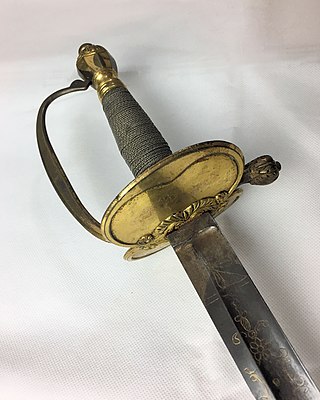
A spadroon is a light sword with a straight-edged blade, enabling both cut and thrust attacks. This English term first came into use in the early 18th century, though the type of sword it referred to was in common usage during the late 17th century. They were primarily used as a military sidearm in the late 17th and early 18th centuries, and for officers and NCOs in the latter part of the 18th and early 19th centuries. The type of sword also saw widespread use across Europe and America, though the term 'spadroon' is unique to the Anglophone world.

During the Middle Ages, an advocatus was an office-holder who was legally delegated to perform some of the secular responsibilities of a major feudal lord, or for an institution such as an abbey. Many such positions developed, especially in the Holy Roman Empire. Typically, these evolved to include responsibility for aspects of the daily management of agricultural lands, villages and cities. In some regions, advocates were governors of large provinces, sometimes distinguished by terms such as Landvogt.
Landdrost was the title of various officials with local jurisdiction in the Netherlands and a number of former territories in the Dutch Empire. The term is a Dutch compound, with land meaning "region" and drost, from Middle Dutch drossāte which originally referred to a lord’s chief retainer, equivalent to:
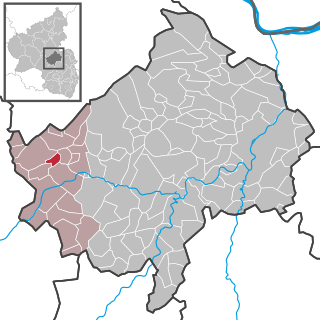
Heinzenberg is an Ortsgemeinde – a municipality belonging to a Verbandsgemeinde, a kind of collective municipality – in the Bad Kreuznach district in Rhineland-Palatinate, Germany. It belongs to the Verbandsgemeinde Kirner Land, whose seat is in the town of Kirn. With only 28 permanent inhabitants, Heinzenberg is the district's smallest municipality.
The ispán or count was the leader of a castle district in the Kingdom of Hungary from the early 11th century. Most of them were also heads of the basic administrative units of the kingdom, called counties, and from the 13th century the latter function became dominant. The ispáns were appointed and dismissed by either the monarchs or a high-ranking royal official responsible for the administration of a larger territorial unit within the kingdom. They fulfilled administrative, judicial and military functions in one or more counties.
In the Middle Ages, the ban or banality was originally the power to command men in war and evolved into the general authority to order and to punish. As such, it was the basis for the raising of armies and the exercise of justice. The word is of Germanic origin and first appears in fifth-century law codes. Under the Franks it was a royal prerogative, but could be delegated and, from the tenth century, was frequently usurped by lesser nobles.
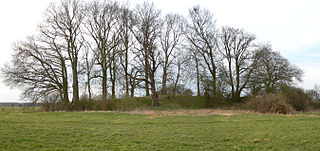
Bunkenburg was a castle built during the 13th and 14th centuries in the shape of a circular fort located on the banks of the Aller opposite Ahlden in north Germany. Only a section of the rampart, roughly 60 metres long and 3 metres high, exists today. The name of the castle is probably derived from the material, bog iron, used for its construction and known in common parlance as Bunke.
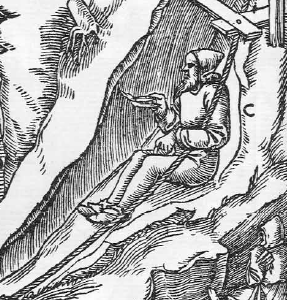
The miner's apron is part of the clothing worn, especially historically, by miners in the mining industries of German-speaking Europe. Variously called in English a miner's apron, a miner's after-apron, breech leather or miner's leather apron, it was a leather apron that served to keep the seat of the trousers from wearing out when working or moving around the mine (Fahrung) as well as keeping out the cold and moisture when sitting. It also provided protection especially when entering inclined mineshafts. Another advantage was that it stabilised the internal organs from mechanical shock and vibration by acting as a sort of kidney belt. The miner's apron was a triangular or, more rarely, semi-circular piece of leather and was supported by the body belt. In Germany the design of the modern miner's apron is governed by DIN standard 23307 Gesäßleder für den Bergbau (Arschleder).
The Burgfrieden or Burgfriede was a German medieval term that referred to imposition of a state of truce within the jurisdiction of a castle, and sometimes its estate, under which feuds, i.e. conflicts between private individuals, were forbidden under threat of the imperial ban.
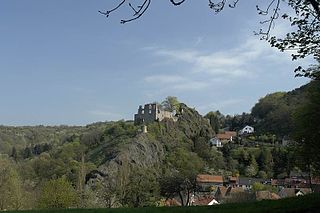
Falkenstein Castle is a ruined hill castle dating to the Middle Ages. It is situated above the eponymous village of Falkenstein on the Donnersberg, the highest point in the Palatinate region, which rises within the German state of Rhineland-Palatinate.